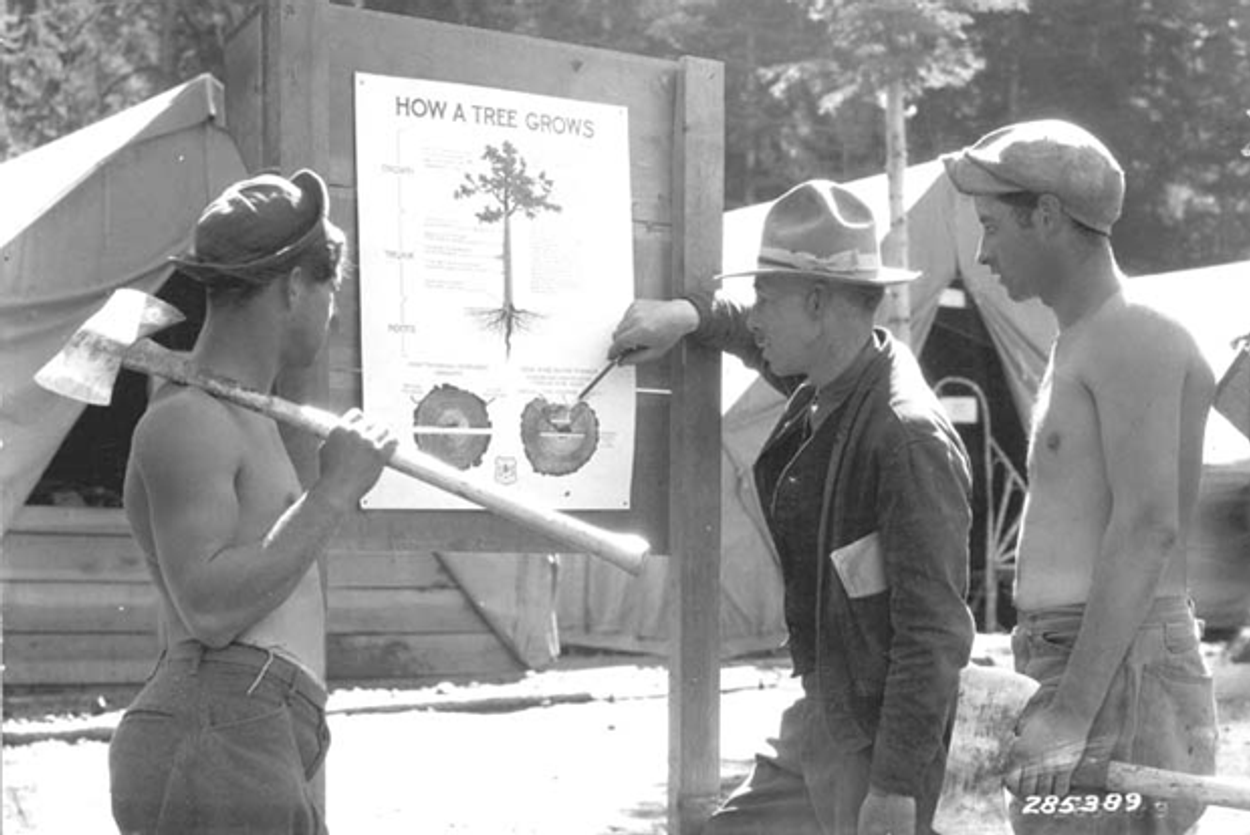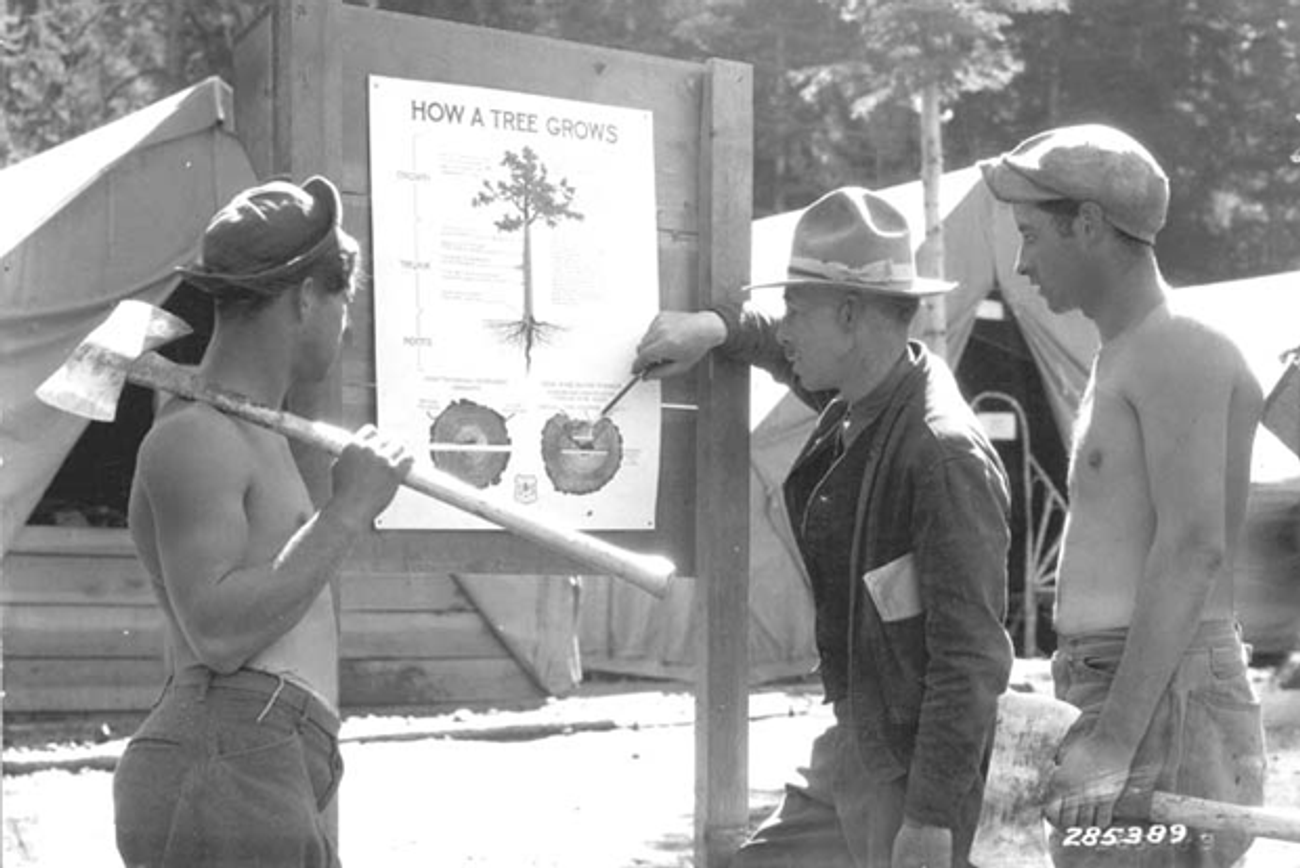Before WWII Began, a Generation of Jewish Men Joined FDR’s ‘Tree Army’
On Tu B’Shevat, recalling how planting trees in the Civilian Conservation Corps helped immigrants’ children become Americans




Trees have always held a special place in Judaism—from the Tree of Life depicted in Jewish liturgy and iconography to this week’s annual observance of Tu B’Shevat. In fact, trees are considered so important to Jews that the sage Shimon bar Yochai taught that “if you are holding a sapling in your hand, and someone says that the Messiah has drawn near, first plant the sapling, and then go and greet the Messiah.” (Avot d’Rebbe Natan 31b)
In the modern Jewish imagination, tree-planting is inexorably tied to the State of Israel and the Jewish National Fund’s iconic blue collection boxes. However, many people don’t realize that Jews were active participants in what became known as America’s own “Tree Army,” the Civilian Conservation Corps program of the 1930s. Each year, thousands of young Jewish men were among those who planted 3 billion saplings from Montana to South Carolina. Along the way, the Jews of the CCC explored unfamiliar parts of the country and shed remnants of their immigrant selves, and for the first time embraced both their American and Jewish identities.
President Franklin D. Roosevelt established the CCC within a month of taking office in 1933. It was the first of several New Deal programs born out of the desperation that followed the stock market crash of 1929. Neil M. Maher, author of Nature’s New Deal, notes that Roosevelt’s interest in conservation developed early in his life at his family’s estate in Hyde Park, N.Y. Roosevelt believed that working in the countryside was therapeutic. But even more urgently, he hoped the CCC would address the nation’s unemployment crisis.
In the early 1930s, more than half of all Americans under age 25 were unemployed. For young Jewish men, obstacles to employment and financial independence were compounded. Anti-Semitism soared during the Depression years, fueled by such radio personalities as Father Charles Coughlin. In New York Jews and the Great Depression, Beth S. Wenger writes: “Raised to believe in America as a land of opportunity and security, young Jews of the 1930s encountered instead a society of limited possibilities, growing anti-Semitism, and social and political turmoil.” For the few available positions, many help-wanted ads noted that “Christians only” need apply. Quotas limited educational opportunities, and families were desperate for any income that young people could provide.
The CCC offered paid employment without religious restrictions: Unmarried, unemployed, male American citizens, ages 18-25, were initially recruited into the CCC from public assistance rolls for work periods of six months, renewable for up to two years. A cooperative effort between the Labor Department, Park Service, and War Department, the program offered regular meals, opportunities for travel, and the means to contribute to the family income. Participants were paid $30 a month, $25 of which they were required to send back to their families.
Once they passed the required physical and arrived at the camps, the men were issued uniforms and supplies, bunked in tents or makeshift wooden structures, and were expected to put in eight-hour work days after breakfast and morning calisthenics. Due to the free and abundant mess hall food, the average CCC participant gained 12 pounds within the first month. Camp rules were strict: Liquor, gambling, and private automobiles were prohibited.
Participants were drawn from all over the nation and while men from some geographic regions were placed together, with the exception of Native American enrollees, participants were not assigned close to home. The number of first-generation Americans was high; according to contemporary reports in the Monthly Labor Review, at least one-quarter of the men had a foreign-born parent. Participants included those from Italian, Irish, and Polish backgrounds. Approximately 3,000 of the 450,000 enrollees in 1934 were Jewish, according to an article in the Jewish Daily Review. Despite welcoming the sons of immigrants, CCC camps did not embrace all Americans. The program remained racially segregated—African Americans participated, but separately—and despite Eleanor Roosevelt’s urging, women were never accepted into the CCC.
The CCC operated in all 48 states and several territories and included not only reforestation, but also the building of fire roads and construction of dams and drainage systems. National Park Service records show that CCC men planted trees as windbreaks during dustbowl conditions in Oklahoma. In Connecticut, CCC participants cleared brush and planted thousands of red pine, Scotch pine, hemlock, and white spruce, according to the Cornwall Historical society. CCC participants also built structures—many of which still exist—in state and national parks.
To keep the young men entertained, recreational trips were organized by camp chaplains who focused on citizenship and character building. Among them was Rabbi Julius Leibert, a former rabbi of Congregation Emanuel in Spokane, Wash. Originally from Lithuania, Leibert adopted his surname in honor of the “liberty” he enjoyed when he immigrated to America. In 1934, the patriotic Leibert organized a grand Fourth of July celebration for all CCC men in his region. Speakers included Idaho’s governor, and participants enjoyed athletic competitions, food, and dancing in a hall erected especially for the occasion. Observances were not limited to civic ones. Within the CCC’s first year, Jewish participants contacted the Association of Rabbis in New York, which arranged with the War Department to provide time off to observant young men.
In 1935, Leibert, along with Catholic and Protestant chaplains, hosted a Rosh Hashanah observance in Spokane, Wash., which drew over 200 Jewish CCC members, including a large group of men originally from Brooklyn, the Bronx, and Trenton, N.J. According to Leibert, it was the first time that the government provided facilities and leave to its officers to carry out a religious service for CCC members. In his sermon, Leibert urged the men to “hold tightly to the liberties this country gives and be loyal citizens,” a sentiment captured in a 1935 article in Spokane’s Spokesman-Review.
Throughout the nation, CCC members were welcomed by established Jewish communities for holiday observances, from Reform Congregation Beth Elohim in Charleston, S.C., to Cincinnati’s Kahlo Kadosh Bene Abraham Congregation (now Rockdale Temple). In some cases, Christian CCC chaplains actually coordinated the events. In 1934, Chaplain Charles I. Conrad remarked, “These are all my boys, and I think as much of having them hold fast to the faith of their fathers as I do of their Protestant and Catholic comrades.” Observances were not limited to those provided for the men by the program. In a camp in Fernwood, Idaho, for example, Jewish CCC men established their own congregation, holding weekly Shabbat services.
Jewish leaders seemed to embrace participation in the CCC, eager to shed immigrant images and reinforce the patriotism of Jewish Americans. In 1934, prominent banker Felix M. Warburg complained that Jewish young men were trying “to take positions in life of the easier kind and they are not working in hard muscle and pioneer activities which every country more or less needs.” The Jewish Welfare Board made efforts to support Jewish CCC participants by providing them with prayer books and tallitot.
In addition to the conservation and employment focus of the CCC, part of the program’s broad popular appeal was its emphasis on physicality, which stood in strong contrast to stereotypes of urban immigrants. CCC recruiting posters reinforced this image by featuring muscled young men wielding axes. Another selling point for the program was its emphasis on citizenship. Capt. Jay Mark Gleason called the CCC a “school of American citizenship, with a half-million pupils.” Men in some locales were provided citizenship training and books from local chapters of the Daughters of the American Revolution. Concerns about Communist influences within the CCC camps loomed large as well; the presence or absence of Communist activities was to be noted in official inspection reports.
At the height of the program in 1935, CCC enrollment peaked at a half-million men, but the program was quickly dismantled after the Pearl Harbor attack on Dec. 7, 1941, and the subsequent U.S. entry into WWII. Many Jewish participants, like their CCC peers, transitioned easily into the armed forces, using their skills, strength, and training to fight for the Allies.
Nine years of the CCC program left an unmistakable mark upon the American landscape and future conservation projects. Numerous state parks, fire roads, shelters, dams, and of course trees are the legacy of the program.
In addition, the program left its mark on the CCC men and the families they helped to support throughout the Depression. When thinking about the program, one can’t help but be reminded of the talmudic encounter between the scholar and the old man planting a carob tree. When asked why he bothered to plant a tree that he would never see to maturity, the old man explained that just as his forefathers had planted trees for him to enjoy, so too would he plant so that his descendants would harvest the fruits of his labor. The young American Jews of the CCC were themselves strengthened and fortified by the experience, firmly taking root in American soil. We are still enjoying the fruits of their labor.
Naomi Sandweiss is the author of Jewish Albuquerque, and a past president of the New Mexico Jewish Historical Society.